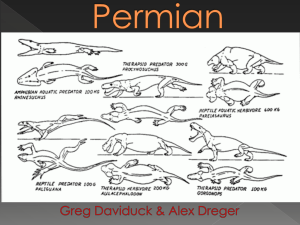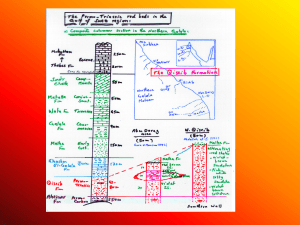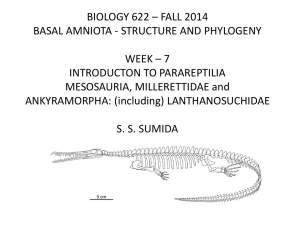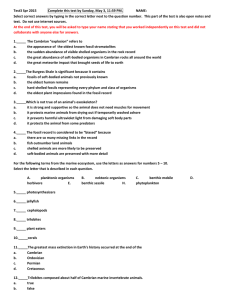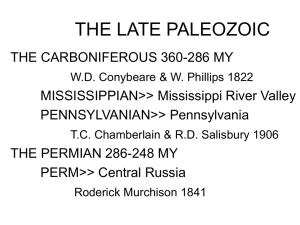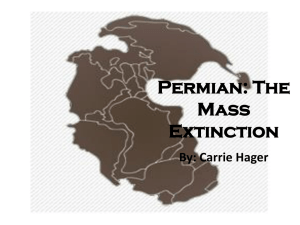The principal morphs of Lower Permian tetrapod tracks
advertisement
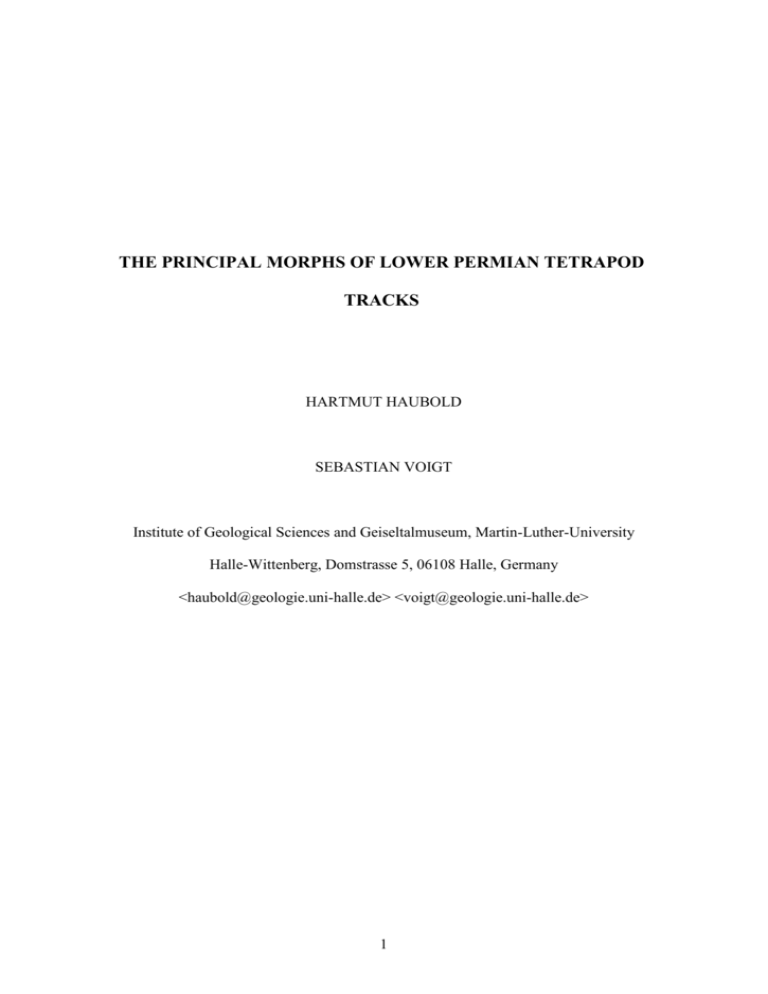
THE PRINCIPAL MORPHS OF LOWER PERMIAN TETRAPOD TRACKS HARTMUT HAUBOLD SEBASTIAN VOIGT Institute of Geological Sciences and Geiseltalmuseum, Martin-Luther-University Halle-Wittenberg, Domstrasse 5, 06108 Halle, Germany <haubold@geologie.uni-halle.de> <voigt@geologie.uni-halle.de> 1 The principal morphs of Lower Permian tetrapod tracks Introduction Recent knowledge of the Lower Permian terrestrial vertebrate fauna is based on osteological and ichnological data. Skeletal remains as well as tetrapod tracks of upper Paleozoic red beds have been known since the 19th century (Case 1907; Cope 1878; Cotta 1848; Credner 1881; Geinitz 1861; Pabst 1908; Williston 1911). The investigation of these originated in North America and Europe due to the prevalence and early recovery of corresponding fossiliferous sediments. However, differences in ancient facies and present habitat in connection with geographic factors have resulted in isolated and partly divergent tendencies of study on each side of the Atlantic. Fossil skeletons and bones have been especially known from the red beds of the United States (Dunkard Basin, Western Interior, Colorado Plateau). Although described by Gilmore (1926-28) and Moodie (1929-30), for example, tracks could not gain attention in the same way. In contrast to that, for a long time the record of Permocarboniferous fossils of some central and western European basins was dominated by tracks and traces. Discoveries of terrestrial tetrapods remained rarely and fragmentary. In the past two decades, accentuated from about 1990 the bias could be contemporaneously attenuated by extensive trackway discoveries in New Mexico (Haubold et al. 1995; Hunt et al. 1993, 1995; Hunt and Lucas 1998; Lucas et al. 2001), and by the recovery of important skeletal remains in Germany (Berman and Martens 1993, Berman et al. 1998-2001; Boy and Martens 1991). The completion and intensified exchange of data is of considerable interest with respect to phylogeny, biostratigraphy, and taxonomy. Based on new facts, now it is possible to determine the anatomically controlled taxa of the 2 Lower Permian tetrapod ichnofauna. Additionally, the reflection of evolutionary trends of the locomotory apparatus by tracks can be used to establish the relationship to potential trackmakers. Lower Permian Terrestrial Tetrapods And Their Locomotion – Evidence From Bone Record The terrestrial vertebrate fauna of Lower Permian Red Beds is dominated by Temnospondyli, Seymouriamorpha, Diadectomorpha, ‚Pelycosauria’, Captorhinomorpha, and Araeoscelidia (Berman et al. 1997; Lucas 1998; fig. 1). Among these, the amniotes indicate a first significant divergence of locomotory abilities (Olsen 1955; Romer 1935; Sumida 1997). This is due to the amniote radiation in the Carboniferous, from which a still incompletely known diversity of terrestrial tetrapods arose in Early Permian time. <FIGURE 1 NEAR HERE> Character transformations of the appendicular skeleton which will be expressed in tracks first of all concern the structure of tarsus and carpus as well as the number, form and orientation of phalanges. These anatomical features determine the lengthwidth ratio of the autopodium as well as the relative length and the arrangement of digits. The tarsus of Lower Permian amniotes is characterized by an increasing consolidation accompanied by a stronger ossification of tarsal and carpal elements. Due to the fusion of tibiale, intermedium and proximal centrale, including the fibulare, two modified protarsal elements result, astragalus and calcaneum. They are considered as amniote synapomorphies (Gauthier et al. 1988; Rieppel 1993; Sumida 1997). Changes of posture, gait and maneuverability of the body are additionally based on 3 modifications of the stylo- and zeugopodium. For example, there is an evolutionary trend toward a flexible acetabulo-femoral articulation and gracile long bones. The locomotorally quite progressive araeoscelids indicate a prolongation of epi- and propodial extremity segments and the development of a rather sigmoid shaped femur (Sumida 1997). These are adaptations for compensation of the increasingly dynamic load of the skeleton, which is accompanying the trend to enhanced agility. The diadectomorhs show modifications in the knee and ankle joint, that are functionally comparable to analogous structures of recent Lacertilia, and which allow a parasagittal orientation of meta- and autopodium (Berman and Henrici 2003). These changes are considered as an adaptation of tetrapods of sprawling type posture and gait to maximize the efficiency of parasagittal thrust caused by the hind limbs. Autopods that are setting down near the body and in the direction of motion induce a higher pace angulation, an enhanced stride, and generally greater maneuverability of the body during locomotion. In contrast, the semiterrestrial to terrestrial representatives of amphibian-like or anamniote Temnospondyli show a quite conservative formation of the locomotory apparatus. The structure of their autopodia seems to have been optimised already during an early stage of the temnospondyl radiation. Apparently after that, relative length, position, and orientation of the digits have hardly changed during the late Paleozoic time span. Presumably due to temporally extended early ontogenetic phases of restriction to water bodies, the carpus and tarsus of these animals maintained a more flexible bone mosaic in comparison to the corresponding structures of amniotes. Early Permian Tetrapod Ichnofauna 4 As showed above, divergent evolutionary tendencies in the anatomy of extremities and of locomotory abilities are documented in body fossils of Lower Permian terrestrial vertebrates. These developments are reflected by the trackway record. The range of pentadactyl amniote track morphologies is extended from that of the Upper Carboniferous. In addition, new types of trackway pattern appear within that group. In contrast to that, tetradactyl ichnotaxa, which are referred to temnospondyls, pass the system boundary without variation. There are six principal morphs of Lower Permian tetrapod tracks, which can be differentiated by means of imprint morphology (fig. 2). As a result of revision and proceeding collections at numerous sites in Europe and North America these six morphs are represented by the following ichnogenera: (1) Batrachichnus Woodworth, 1900, Limnopus Marsh, 1894 (2) Amphisauropus Haubold, 1970, (3) Ichniotherium Pohlig, 1892, (4) Dimetropus Romer & Price, 1940, (5) Hyloidichnus Gilmore, 1927, Varanopus Moodie, 1929, Gilmoreichnus Haubold, 1970, Erpetopus Moodie, 1929, (6) Dromopus Marsh, 1894, Tambachichnium Müller, 1954. The six principal morphs will be subsequently explained and characterized. (1) Batrachichnus - Limnopus Batrachichnus and Limnopus are interpreted as tracks of terrestrially adapted temnospondyls of different body size (Haubold 1970, 1971, 1996, 2000; Hunt et al. 1995). Their tracks differ from all other mentioned ichnogenera by the tetradactyl manus imprint. Batrachichnus has been described by Woodworth (1900) from the Conemaugh Series of the Upper Carboniferous of Massachusetts. The genus is one of the predominant taxa of the Permocarboniferous ichnofauna. There are only two formal 5 and geographically distinguishable Permian ichnospecies: Batrachichnus delicatulus (Lull, 1918), e. g., from the Wolfcampian Hueco Group of New Mexico (Haubold et al. 1995), and Batrachichnus salamandroides (Geinitz, 1861), which is widely distributed in the central European Rotliegend (Haubold 1996). Both are probably synonyms of Batrachichnus plainvillensis Woodworth, 1900. Marsh (1894) has established the taxon Limnopus for tracks from the Howard Limestone Formation, Virgil Series, of the Upper Pennsylvanian of Osage, Osage County, Kansas (Baird 1952). Limnopus is attributed to larger imprints than Batrachichnus. Major differences concern the width of pace, the length width ratio of the imprints, and the digit lengths of the manus imprint, in particular. (2) Amphisauropus and (3) Ichniotherium The ichnotaxa Amphisauropus and Ichniotherium are interpreted as Seymouriamorpha and Diadectomorpha, respectively. The tracks of both genera show a considerable similarity in the arrangement of the digits. However, the pes imprints differ in respect to the length of digit V and the shape of sole. In Ichniotherium the last is characterized by an ovate, transversally extended, and often sharply outlined heel pad (Voigt & Haubold 2000). In contrast, the sole and digits form nearly a structural unit in the Amphisauropus imprint. <FIGURE 2 NEAR HERE> The Diadectidae record a step wise consolidation of the proximal tarsus, resulting in the formation of the astragalus and calcaneum (Berman and Henrici 2003). Whereas basal family members are still showing sutures of the tripartite origin of these tarsal bones, sutures are lost in more advanced relatives. Finally, the most progressive 6 of the known Diadectes species indicate a fusion of the astragalus and calcaneum to create an astragalo-calcaneum complex. It is a prominent, mediolaterally extended element of the proximal tarsus, which convincingly fits the oval heel imprint of Ichniotherium cottae (Pohlig, 1885). In Limnoscelidae and Tseajaiidae, rather primitive taxa of Diadectomorpha, the astragalus and calcaneum are still absent (Berman and Henrici 2003). Consequently, in these forms a similar structure of the sole imprint can not be expected. That’s why apart from seymouriamorphs, basal diadectomorphs have to be taken into account as potential trackmakers of Amphisauropus. The locus typicus of Amphisauropus is situated in the Goldlauter Formation of the Thuringian Forest, Germany (Haubold 1970). Numerous specimens of the ichnogenus come from Europe (Haubold 1996; Haubold and Stapf 1998), and, recently, in increasing extent also from North America (Lucas et al. 2001). The ichnotaxon is limited to Permian sediments as yet. Ichniotherium is an ubiquitous element of the Thuringian Forest Rotliegend ichnofauna. The best record comes qualitatively as well as quantitatively from the type locality of the Tambach Formation (Pabst 1908; Haubold 1998; Voigt 2001, 2002). With the exception of the holotype of Ichniotherium willsi Haubold and Sarjeant, 1973 from the Upper Carboniferous of England, all other Ichniotherium specimens from outside of the Thuringian Rotliegend are only preserved as single imprints (Gand 1987; Haubold 1971, 1973; Haubold and Stapf 1998; Hunt et al. 1995). Due to incompleteness of the record and preservation their identification still remains uncertain. 7 (4) Dimetropus Dimetropus imprints, which are interpreted as tracks of carnivorous Eupelycosauria, are characterized by an extended sole, stressed and circular shaped metatarsal phalangeal pads, slender digits, and tapered claws (Haubold 1971-2000; Haubold et al. 1995). The characteristics of imprint morphology will rapidly be lost in the common undertrack preservation by decreasing clarity of outlines. In that case, the imprints indicate a proximodistally extended, narrow sole and short, and slender digits. Dimetropus is a widely distributed ichnotaxon of Permocarboniferous red beds (Haubold 1996; Haubold et al. 1995). Three ichnospecies are differentiated: Dimetropus leisnerianus (Geinitz, 1863), D. bereae (Tilton, 1931), and D. nicolasi Gand and Haubold, 1984. Criteria for species separation still remain under discussion. (5) Hyloidichnus, Glimoreichnus, Varanopus, and Erpetopus The representatives of these four genera are collected as one basic morph due to the similarity of the digit arrangement and proportions, respectively, in manus and pes imprint. Both kind of imprints are characterized by a moderate increase of digit length from I to IV, remarkably acute angled hypex, inward curved prints of claws as well as a laterally oriented digit V. The imprints of digit tips often show an extramorphologically caused bifurcation. Referred trackmakers are “pelycosaurs” to captorhinomorphs. Up to now a more detailed interpretation is not possible due to the nearly uniform proportions of phalanges and digits of known skeletons (Haubold 2000). The differentiation of the four ichnotaxa is limited in a similar manner. Only in the case of well recorded preservation there is a character for separation by the relative length and orientation of digit V on the manus and pes imprints. However, due to various conditions in substrate 8 and gait many transitions in preservation of imprints and trackway patterns exist. They complicate differentiation and even sometimes identification of the forms. The Hermit Shale of the Grand Canyon (Gilmore 1926, 1927; Haubold 1973) is the stratum typicum of type species of Hyloidichnus and Gilmoreichnus, H. bifurcatus Gilmore, 1927, and G. (Hylopus) hermitanus (Gilmore, 1927), respectively. Further specimens of the taxa come from south-western France (Gand 1987) and New Mexico (Haubold et al. 1995). Varanopus and Erpetopus has been described by Moodie (1929) based on the type genera V. curvidactylus and E. willistoni from the Choza Formation, Texas. A reexamination and collecting of additional material at the type locality has confirmed the state of both ichnogenera as valid taxa (Haubold and Lucas 2001). Varanopus is also known from the Lower Permian of New Mexico, France and Germany. There are presumptive Erpetopus specimens in France and Italy (Haubold and Lucas 2001). (6) Dromopus and Tambachichnium This basic morphotype unites imprints of so called lacertoid or lizard-like shape. That means the manus and pes present long and slender, claw-bearing digits, which are distally curved inwards. Digit length increases from I to IV. Digit V is straight, conspicuously shorter than IV and straddled away from the last in a different manner. Dromopus and Tambachichnium are interpreted as tracks of araeoscelids (Haubold 2000). That interpretation is quite convincing and generally accepted. Support comes from both the proportions of the body and extremities and by known skeletons of the manus and pes. Dromopus has been described by Marsh (1894) based on collections from the Upper Carboniferous of Kansas. Aside from Batrachichnus, the ichnogenus is the most common element of the Upper Carboniferous to Lower Permian ichnofauna. 9 Dromopus (Saurichnites) lacertoides (Geinitz, 1863) in Europe and D. agilis Marsh, 1894 in North America are regionally applied species names. Haubold (1996) takes the view that both species are identical to one another. As yet, a separation could not be explained. In a strong sense, the differentiation between D. lacertoides / agilis and D. palmatus (Moodie, 1929) = D. didactylus (Moodie, 1930) still remains an unresolved problem. Digit III and IV are the most prominent and even often the only elements of D. palmatus imprints. In addition, digit V seems to be abducted farther backwards. Accordingly, it could be concluded that the trackmaker has longer metacarpalia and metatarsalia in comparision to that of D. lacertoides (Haubold and Lucas 2001). In contrast to Dromopus, Tambachichnium presents straight digits of smaller divarications and presumably a more variable trackway pattern. Until now the ichnotaxon is only known from the Tambach Formation in Thuringia by few specimens, one trackway segment and three isolated and disputable imprints (Müller 1954; Haubold 1998). <FIGURE 3 NEAR HERE> The trackway pattern The trackway pattern is determined by body proportions of the trackmaker, especially the coupling value. This is the ratio of the gleno-acetabular distance to the length of extremities. Variation of the trackway pattern of Lower Permian tetrapod ichnotaxa is comparatively uniform. This means that the body proportions of associated trackmakers could not have had great differences. If at all existing, in most cases these differences were not prominent enough to appear in the trackway. Thus, the trackway pattern of upper Paleozoic tetrapod ichnia is only a character of secondary ichnotaxonomic importance (Haubold 1996). Nevertheless, there is a spread of 10 different trackway patterns within each single ichnospecies (fig. 3). That range reflects variable speed of trackmaker locomotion (Voigt and Haubold 2000; Voigt 2001). Among the Lower Permian ichnotaxa, low speed of gait is recorded by trackways, in that in one the manus imprint of the left side is faced to the pes of the right side, and vice versa. With increasing speed of gait, manus and pes of each single set from left and right side, respectively, approach one another. The result is a primary overstepping with a partial covering of imprints. Erpetopus, Tambachichnium and Dromopus represent deviation from that spread of trackway pattern. Only from specimens of these three ichnogenera an optional, completely primary overstepping of manus imprint by the pes is known (Haubold 1971, 1973; Haubold and Lucas 2001; fig. 3). In addition, the lacertoid tracks, Dromopus and Tambachichnium, show different width of pace on the hind and the front feet. The larger width of pace on the hind limb as well as an enhanced variability of trackway pattern correlate with the anatomically recorded transformations of appendicular skeletons of the animals as mentioned above. In some instances, the different orientation of manus and pes within the trackway gains ichnotaxonomic importance. Amphisauropus is characterized by a significant divergence of manus and pes axis with respect to the direction of motion. Manus imprint is generally oriented inwards, whereas the pes points outwards. The axis of both are separated by up to 50°. That character can take on importance as a criterion for differentiation between tracks of Amphisauropus and Batrachichnus/ Limnopus. In particular, it applies to doubtful cases of extramorphologically distorted tracks, where the real number of digits on the fore feet can not be clarified. Summary 11 The described imprint morphologies and trackway patterns can be considered as representative forms of the Lower Permian tetrapod ichnofauna. The result is supported by numerous conceptual integrative specimens from widely distributed equatorial to subequatorial areas of Pangaea (fig. 4). The ichnotaxa, characterized in the previous paragraphs, reflect the spectrum of terrestrial tetrapods of this time period that are distinguishable by imprint morphology and trackway pattern. Tetrapod tracks from the Permian are represented in scientific papers by 150 names of genera and about 280 species names (Haubold 2000). The majority of these are referred to Lower Permian ichnotaxa. All up to now separated and named Lower Permian ichnotaxa can be principally referred to the six basic morphs discussed in this paper. Four of these basic morphs are already known from specimens from the Upper Carboniferous. These are (1) Batrachichnus/ Limnopus, (2) Ichniotherium, (3) Dimetropus and (4) Dromopus. The diversity is extended to six basic morphs with 11 ichnogenera altogether in the Lower Permian due to evolutionary progress of the locomotory apparatus of synapsids and eureptiles. The majority of the ichnofauna and occurrences, respectively, are dominated by Batrachichnus, Dimetropus and Dromopus. They represent, presumably, tracks of temnospondyls, sphenacodontid “pelycosaurs” and araeoscelids. <FIGURE 4 NEAR HERE> The example of microsaurs shows that possibly not all osteologicallyestablished taxa can be recorded by ichnological specimens. Terrestrially adapted tuditanomorph microsaurs range from the Upper Carboniferous to the Early Permian. They have shorter extremities in relation to the glenoid-acetabulum distance than do temnospondyls. The differences in body proportions should be reflected in the trackway pattern by secondary overstepping. However, separation of trackways with 12 complete secondary overstepping from such with primary or without overstepping is generally difficult. Therefore, it is doubtful to identify only from trackway pattern distinct trackmakers without any significant character deviation in imprint morphology. The majority of microsaurs have a tetradactyl manus, a character they share with temnospondyls. Therefore, as yet it is impossible to document microsaur tracks in the Lower Permian Red beds or to separate them from the Batrachichnus/ Limnopus track morph. Parallelisms or convergent developments inducing almost identical or functionally homologous extremity morphologies can limit the specification of osteological trackway interpretation in some cases. In addition, the postcranium is of less taxonomic importance than the anatomy of the cranium, which represents the base of the tetrapod evolutionary system in the Permian Period, too. However, in particular, the structure of the distal extremities of Lower Permian terrestrial vertebrates are of sufficient significance to allow the differentiation of at least six principal track morphs. It establishes an interpretation of fossil tracks and trackways that is based on anatomical characters of the trackmakers. In that way, ichnia tetrapodorum are another kind of tool for stratigraphic and faunistic conclusions, which should be considered as supplementary and controlling factors of osteological data. Acknowledgment. Special thanks to Dr. Spencer Lucas for revising the English. References Baird, D. 1952. Revision of the Pennsylvanian and Permian footprints Limnopus, Allopus and Baropus. Journal of Paleontology 26: 832-840. 13 Berman, D. S., and Henrici, A. 2003 (in press). Tarsus of diadectidae. Journal of Paleontology. Berman D. S., and Martens, T. 1993. First occurence of Seymouria (Amphibia, Batrachosauria) in the Lower Permian Rotliegend of central Germany. Annals of Carnegie Museum of Natural History 62: 63-79. Berman, D. S., Reisz, R. R., Martens, T., and Henrici, A. 2001. A new species of Dimetrodon (Synapsida: Sphenacodontidae) from the Lower Permian of Germany records the first occurrence of genus outside of North America. Canadian Journal of Earth Sciences 38: 803-812. Berman, D. S., Reisz, R. R., Scott, D., Henrici, A., Sumida, S. S., and Martens, T. 2000. Early Permian bipedal reptil. Science 290: 969-972. Berman D. S., Sumida, S. S., and Lombard, R. E. 1997. Biogeography of primitive amniotes. In S. S. Sumida, and K. L. M. Martin (eds.), Amniote Origins: Completing the Transition to Land, pp. 85-139. Sand Diego: Academic Press. Berman, D. S., Sumida, S. S., and Martens, T. 1998. Diadectes (Diadectomorpha: Diadectidae) from the Early Permian of central Germany, with description of a new species. Annals of Carnegie Museum of Natural History 67: 53-93. Boy, J. A., and Martens, T. 1991. Ein neues captorhinomorphes Reptil aus dem thüringischen Rotliegend (Unter-Perm, Ost-Deutschland). Paläontologische Zeitschrift 65: 363-389. Case, E. C. 1907. Revision of the Pelycosauria of North America. Publication of the Carnegie Institute, Washington 55: 176 p. 14 Cope, E. D. 1878. Description of extinct Batrachia and Reptiles from the Permian formation of Texas.- Proceedings of the American Philosophical Society, Philadelphia 17: 505-530. Cotta, B. v. 1848. Briefliche Mitteilung an von Leonhard. Neues Jahrbuch für Mineralogie, Geognosie, Geologie und Petrefaktenkunde 1848: 133-134. Credner, H. 1881. Über einige Stegocephalen und Saurier aus dem Rotliegenden des Plauenschen Grundes bei Dresden, Teil 1. Zeitschrift der Deutschen Geologischen Gesellschaft 33: 298-333. Gand, G. 1987. Les traces de vertébrés Tétrapodes du Permien français. These de Doctorat d’etat des Sciences Naturelles, Université de Bourgogne, Edition Centre des Sciences de la Terre, 341 pp. Dijon. Gauthier, J. A., Kluge, A. G., and Rowe, T. 1988. The early evolution of the Amniota. In M. J. Benton (ed.), The Phylogeny and Classification of the Tetrapods, pp. 103-155. Oxford: Clarendon Press. Geinitz, H. B. 1861. Dyas I, 130 pp. Leipzig: Wilhelm Engelmann. Gilmore, C. W. 1926. Fossil footprints from the Grand Canyon. Smithsonian miscellaneous collections 77: 1-41. Gilmore, C. W. 1927. Fossil footprints from the Grand Canyon. II. Smithsonian niscellaneous collections 80: 1-78. Gilmore, C. W. 1928. Fossil footprints from the Grand Canyon. III. Smithsonian miscellaneous collections 80: 1-16. Haubold, H. 1970. Versuch der Revision der Amphibienfährten des Karbon und Perm. Freiberger Forschungshefte C 260: 83-117. 15 Haubold, H. 1971. Ichnia Amphibiorum et Reptiliorum fossilium. In O. Kuhn (ed.), Encyclopedia of Paleoherpetology, part 18, pp. 1-124. Stuttgart: Gustav Fischer. Haubold, H. 1973. Die Tetrapodenfährten aus dem Perm Europas.- Freiberger Forschungshefte C 285: 5-55. Haubold, H. 1996. Ichnotaxonomie und Klassifikation von Tetrapodenfährten aus dem Perm. Hallesches Jahrbuch für Geowissenschaften B 18: 23-88. Haubold, H. 1998. The Early Permian tetrapod ichnofauna of Tambach, the changing concepts in ichnotaxonomy.- Hallesches Jahrbuch für Geowissenschaften B 20: 1-16. Haubold, H. 2000. Tetrapodenfährten aus dem Perm- Kenntnisstand und Progress 2000. Hallesches Jahrbuch für Geowissenschaften B 22: 1-16. Haubold, H., Hunt, A. P., Lucas, S. G., and Lockley, M. G. 1995. Wolfcampian (Early Permian) vertebrate tracks from Arizona and New Mexico. New Mexico Museum of Natarual History and Science Bulletin 6: 135-165. Haubold, H., and Lucas, S. G. 2001. Die Tetrapodenfährten der Choza Formation (Texas) und das Artinsk-Alter der Redbed-Ichnofaunen des Unteren Perm. Hallesches Jahrbuch für Geowissenschaften B 23: 79-108. Haubold, H., and Stapf, H. 1998. The Early Permian track assemblage of Nierstein, Standenbühl Beds, Rotliegend, Saar-Nahe Basin, SW-Germany. Hallesches Jahrbuch für Geowissenschaften B 20: 17-32. Hunt, A. P., Lockley, M. G., Lucas, S. G., MacDonald, J. P., Hotton, N., and Kramer, J. 1993. Early Permian tracksites in the Robledo Mountains, south-central New Mexico.- New Mexico Museum of Natarual History and Science Bulletin 2: 615-639. 16 Hunt, A. P., and Lucas, S. G. 1998. Implications of the cosmopolitanism of Permian tetrapod ichnofaunas. New Mexico Museum of Natarual History and Science Bulletin 12: 55-57. Hunt, A. P., Lucas, S. G., Haubold, H., and Lockley, M. G. 1995. Early Permian (late Wolfcampian) tetrapod tracks from the Robledo Mountains, south-central New Mexico. New Mexico Museum of Natarual History and Science Bulletin 6: 167180. Lucas, S. G. 1998. Towards a tetrapod biochronology of the Permian. New Mexico Museum of Natarual History and Science Bulletin 12: 71-91. Lucas, S. G., Lerner, A. J., and Haubold, H. 2001. First record of Amphisauropus and Varanopus in the Lower Permian Abo Formation, central New Mexico. Hallesches Jahrbuch für Geowissenschaften B 23: 69-78. Marsh, O. C. 1894. Footprints of vertebrates in the Coal Measures of Kansas. American Journal of Science 3: 81-84. Moodie, R. L. 1929. Vertebrate footprints from the Red Beds of Texas. American Journal of Science 97: 352-368. Moodie, R. L. 1930. Vertebrate footprints from the Red Beds of Texas. Journal of Geology 38: 548-565. Müller, A. H. 1954. Zur Ichnologie und Stratonomie des Oberrotliegenden von Tambach (Thüringen). Paläontologische Zeitschrift 28: 189-203. Olson, E. C. 1955. Parallelism in the evolution of the Permian reptilian faunas of the Old and New World. Fieldiana Zoology 37: 385-401. Pabst, W. 1908. Die Tierfährten in dem Rotliegenden Deutschlands.- Nova Acta Leopoldina 89: 315-480. 17 Romer, A. S. 1935. Early history of Texas red-beds vertebrates. Bulletin of the geological Society of America 46: 1597-1658. Rieppel, O. 1993. Studies on skeleton formation in reptiles. IV. The homology of the reptilian (amniote) astragalus revisited. Journal of Vertebrate Paleontology 13: 31-47. Sumida, S. S. 1997. Locomotor features of taxa spanning the origin of amniotes. In S. S. Sumida, and K. L. M. Martin (eds.), Amniote Origins: Completing the Transition to Land, pp. 353-398. Sand Diego: Academic Press. Voigt, S. 2001. Variation and preservation of Ichniotherium cottae in the Tambach Sandstone (Rotliegend, Thuringia). Natura Bresciana 25: 221-225. Voigt, S. 2002. Zur Geschichte der Tetrapodenfährtenfunde in den Sandsteinbrüchen bei Tambach-Dietharz (1887-1908). Abhandlungen und Berichte des Museums der Natur Gotha 22: 47-58. Voigt, S., and Haubold, H. 2000. Analyse zur Variabilität der Tetrapodenfährte Ichniotherium cottae aus dem Tambacher Sandstein (Rotliegend, Unterperm, Thüringen). Hallesches Jahrbuch für Geowissenschaften B 22: 17-58. Williston, S. W. 1911. American Permian Vertebrates, 145 pp. Chicago: University Press. Woodworth, J. B. 1900. Vertebrate footprints on carboniferous shales of Plainville, Massachusetts. Bulletin of the Geological Society of America 11: 449-454. 18 FIGURE LEGENDS FIGURE 1-Temporal distribution of tetrapod taxa with potential terrestrial representatives during the Lower Permian based on Lucas (1998). Most of the tetrapod track-bearing strata mentioned in the text, the Goldlauter and the Tambach Formation, the Hermit Shale, and the Choza Formation, for example, are considered to belong to the Cisuralian – Lower Permian – time series. FIGURE 2-Representatives of the six significant Lower Permian track morphs and osteological taxa of inferred trackmakers. In all cases, the manus imprint is in front of the pes. The photograph of Dromopus only shows the pes imprint. In the related drawing below the outline of the manus print is added. Line drawings are not scaled. FIGURE 3-Typical Lower Permian trackway patterns (modified after: Haubold 1971). The majority of studied trackways are spanning a range between 1 and 3. Striking overstepping of pattern number 4 is only recorded in specimens of Erpetopus, Dromopus, and Tambachichnium as a result of higher speed of gait. FIGURE 4-Lower Permian – Cisuralian - Pangaea (based on: Paleogeographic Atlas Project, University of Chicago) showing position of the most important Lower Permian tetrapod track locality areas of North America and Europe which both were arranged in equatorial latitudes during that period. The tetrapod ichnofossil assemblages, the bone record, and the paleogeography confirm the supposition of an extended uniform habitat across the central part of the supercontinent. 19
